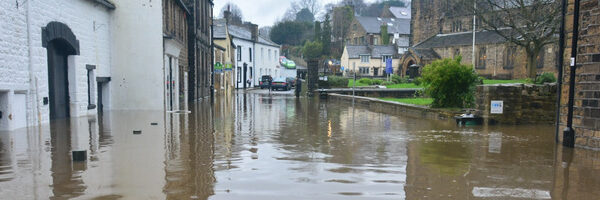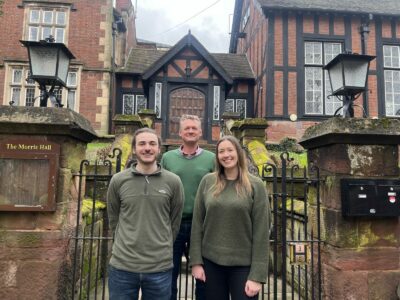Contents
- What is contaminated land?
- What is a contaminated land risk assessment?
- What are the four phases of contaminated land risk assessment?
- What is a walkover?
- What are special sites?
- What are the risks of building or living on contaminated land?
- What does the national planning policy state about contaminated land?
- How is contaminated land treated?
- How long can land be contaminated for?
- Is it good to build on brownfield sites?
What is contaminated land?
Contaminated land is defined as ground which contains substances that are or could be potentially hazardous to human health and the environment.
Land is determined as contaminated if:
- It contains significant levels of a contaminant.
- Someone or something could be affected by the contaminant.
- The contaminant can get to the receptor in significant quantities.
If a site is contaminated, a specialist will be able to identify a pathway between the source of the contamination, the subject affected by the contaminant and how the contaminant is transferred to the subject. This connection is known as the pollutant linkage.
Although it is hard to estimate how much contaminated ground exists in the UK, sites which have previously been developed for industrial use such as petrol stations, gas works, oil depots and factories are highly likely to have chemicals and harmful substances which can cause the land to become contaminated.
What is a contaminated land risk assessment?
Often required as part of planning applications, a contaminated land risk assessment report, also known as a contaminated land survey or contaminated ground risk assessment, is an integrated analysis of a site to evaluate what degree of contamination is present.
The assessment identifies the contamination potential, what level of risk present contaminants pose and whether actions are required to mitigate or remediate the hazard.
Prior to the purchase of land, contaminated land assessments are advisable to have carried out to ensure that planning conditions set out by your local authorities, the National House Building Council or the Environment Agency are met.
If you do not have a contaminated land assessment completed when your local contaminated land officer has requested one, your planning permission will not be granted.
A contaminated land assessment from GeoSmart can be made up of four phases, outlined below. You may or may not require all four contaminated land services – it will depend on your site and what degree of contamination issues are detected.
What are the four phases of a contaminated land risk assessment?
Phase 1: desk study and site survey
Also known as a preliminary risk assessment or a contaminated land report, a phase 1 desk study provides a qualitative assessment to determine:
- The likelihood that sources of contamination are present within the subsurface, beneath the site or close by.
- The consequences or severity of any impacts from present contamination.
- The risks posed by the site to the proposed future users, buildings and the wider environment.
“Phase 1 desk studies are designed to look at the history of a site, going back 100 to 150 years to see if there are any potential risks which could affect future users”, advises Martin Lucass, GeoSmart’s commercial director and specialist in contaminated land.
To obtain a clear picture of the possible hazards, the desk study refers to historical ordnance survey maps, aerial photographs, local and national archives, geological records, groundwater vulnerability maps, and regulatory records.
Phase 1 desk studies are carried out by experts who follow the government’s guidance on land contamination risk management and will identify whether a source-pathway-receptor connection exists.
In some cases, a site visit may be undertaken to review the sufficiency of mapped data and understand if an intrusive site investigation is required.
Phase 2: intrusive investigation
If the phase 1 desk study indicates there is potentially contaminated land, a phase 2 intrusive site investigation and refined risk assessment will be required.
These will determine whether there are any unacceptable risks to people, property or the environment and, depending on the information provided, will lead to remediative action.
Corrective work can range from a simple soil sampling exercise using hand dug pits to borehole drilling, soil testing and groundwater and gas monitoring.
Phase 3: remediation
If the contaminated land investigation identifies any unacceptable risks from poisoned or toxic land, remediation or mitigation measures may be required to enable the construction of commercial or residential developments to proceed.
Both actions involve the breaking of the pollutant linkage, a name describing the connection between the contaminating source, the pathway through which the contaminant inflicts harm and the specified receptor that is affected by the contaminant.
Planning authorities require this linkage to be broken so that the pollutant cannot cause harm and the site can be considered as suitable for use.
There are many ways to break the pollution linkage, from the traditional removal of contamination, to on-site treatment or the use of barrier membranes or capping.
Phase 4: verification
Work undertaken during the remediation stage is verified or validated to ensure the site is free of contamination and the site is fit for purpose. If you are developing in a contaminated area or are a property owner dealing with this issue, contaminated land insurance can help to cover the costs of remediation and additional expenses.
It is important to consider what land contamination insurance options are available to you when having a contaminated land site assessment carried out.
Prior to the purchase of land, contaminated land assessments are advisable to have carried out to ensure that planning conditions set out by your local authorities, the National House Building Council or the Environment Agency are met.
If you do not have a contaminated land assessment completed when your local contaminated land officer has requested one, your planning permission will not be granted.
A contaminated land assessment from GeoSmart can be made up of four phases, outlined below. You may or may not require all four contaminated land services – it will depend on your site and what degree of contamination issues are detected.
What is a walkover?
As part of the phase 1 desk study, the Local Authority or consultants such as ourselves will recommend a walkover.
This involves a qualified contaminated land professional visiting the site and reviewing and recording all of the ongoing and recent site activities.
Alongside this, our specialist will look for evidence of any historical activities which may have taken place on the site, as well as observing the surrounding area and obtaining site plans and data from the site users to support the report.
What are special sites?
In certain cases, contaminated land regulations in the UK class some polluted land as special sites due to their location, who owns the site and how it has been contaminated.
Contaminated sites that can be labelled as special sites include:
- Areas which contain or are located near drinking waters, surface waters or important groundwater sources.
- Land which has been, or is being, used for certain industrial activities, such as oil refining or making explosives.
- Sites that are being or have been regulated using a permit issued under the integrated pollution control or pollution prevention and control regimes.
- Sites which have been used to get rid of waste acid tars.
- Land owned or occupied by the Ministry of Defence.
- Land that has been contaminated by radioactivity.
- Nuclear sites.
What are the risks of building or living on contaminated land?
With potentially poisonous and carcinogenic materials present, contaminated land can be dangerous for people working and living on it.
Direct effects of polluted sites can include inhalation of gases and dust, contact with soil and the consumption of food grown on the land.
Harmful substances present on such land can include arsenic, lead, oils, tars, asbestos, gases, solvents and radioactive materials.
“Asbestos will show up on most sites as it was used for quite a number of decades and different types of asbestos come with different types of risk”, said Martin.
“If you have a site that had anything built and subsequently demolished between the ‘40s and the ‘80s, you are pretty much guaranteed to have asbestos in the ground on your site.”
Due to risk carried by asbestos and other harmful materials, it is good practice to seek contaminated land advice or contamination information to understand what you could be dealing with.
What does the national planning policy state about contaminated land?
According to paragraphs 183 of the National Planning Policy Framework, planning policies and decisions should consider whether a site is suitable for its proposed use with consideration of the ground conditions.
This includes regarding the risks of natural and manufactured hazards, plans to mitigate them and assessing the environmental impact of remediation.
Planning bodies will also ensure that land cannot be identified as contaminated following remediation, in accordance with the Part IIA of the Environmental Protection Act 1990.
As a side note, development on contaminated land which has been highlighted as being polluted by a local planning authority should not proceed until an assessment has been completed and proven the site to be decontaminated.
How is contaminated land treated?
There are many methods to treat ground contamination – it depends on the complexity and type of the contaminant.
For a substance like asbestos which is made up of microscopic fibres and extremely difficult to pick up individually, remediation strategies might recommend covering it over with a material like concrete.
In contrast, robust, living contaminants like Japanese knotweed cannot be as easily removed.
“For Japanese knotweed you have to eradicate the roots otherwise it can regrow though the ground. To do this, you can set up a picking line on site to dig up the contaminated soils and pick out all the bits of Japanese knotweed”, Martin explained.
Maintaining the removal of the knotweed will involve seasonal treating which will eventually kill the plant.
In cases where a site is contaminated by large amounts of oil, the substance can either be pumped out, sold and reused or taken to a specialist landfill which deals with hazardous waste.
How long can land be contaminated for?
In theory, land can be contaminated forever but the amount of contamination that is considered to be a risk can diminish over time.
For instance, short chain hydrocarbons like natural gases are highly volatile and largely turn into a vapour if petrol is poured on them.
In contrast, a substance like diesel will remain on a site for a very long time. This is also common with other oils and tar which, as a dense, non-aqueous phase liquid, will soak through the ground soils and sink to the bottom of groundwater below. Once it’s there, it is very difficult to remove.
Is it good to build on brownfield sites?
Brownfield land is any site which has been previously developed upon whereas greenfield land denotes any national parks, green space and open areas which have been left untouched by urbanisation.
In light of preserving the UK’s green spaces and biodiversity, there have been calls from organisations such as The Countryside Charity to make use of brownfield land for new developments.
Whilst the recycling of brownfield sites is sustainable and makes good use of derelict areas, the cost of decontaminating the land is one its biggest disadvantages.
Equally, from an ecological perspective, the developmental destruction of biodiversity which often thrives in the untouched and varied landscapes of brownfield land is a huge downside.
We’re ready when you are…

Get an Expert View on Contaminated Land
We have many years experience in assessing land quality, site investigations and recommending next steps, as part of Master planning and pre-application submissions.
We have a proven track record of delivering successful outcomes through our technical expertise.
Our contaminated land risk assessment reports provide:
- A Phase 1 risk assessment on the past use of the site
- A manual review of historical maps of the site
- A consultant’s professional opinion
- Options for providing a site walkover and review of the planning history.
- Expert help to discharge planning conditions
For more information take a look at the FAQs below or contact our team today.
Frequently Asked Questions
A Phase 1 Contaminated Land Report is a literature-based review designed to give an overview of the risk of land or groundwater contamination to end-users (house occupiers or workers) and the immediate environment.
A Phase 1 Study collates relevant information from a variety of sources relating to the setting of the site and its previous historical uses. The end product is an interpretive report that contains a qualitative risk assessment, including a conceptual site model that describes the potentially significant sources of contamination, receptors and pathways.
The study involves multiple sources of information often including Ordnance Survey maps, geological and groundwater vulnerability maps, aerial photographs, local and national archives, and newspapers and registers held by relevant regulatory agencies. A site walkover (land investigation) may be required to support the collated desk-based information, to provide details of the current condition of the site, and to gather evidence of potential contamination.
When a site walkover is requested, we will generally conduct the walkover following the initial desk study to ensure a ‘best value’ approach in meeting regulations and individual report needs.
A Phase 1 Study collates relevant information from a variety of sources relating to the site setting and its previous historical uses. The end product is an interpretive report that describes the likely presence of any contamination within the subsurface, and the potential risks that this may pose to future site users and the immediate environment. A site walkover may be required to support the desk study information and to provide greater certainty in the report findings.
- Property developers
- Self-build
- Property professionals such as architects, planning consultants and land agents
- Lawyers and solicitors
- Lenders, banks or mortgage providers
- Businesses
- Insurance companies
- Validating planning applications
- Meeting planning conditions
- For land and property purchase
- For the sale or divestment of a site
- Due diligence
- Lending, mortgages, pension funds
- Business risk assessment
If land is highlighted by the local planning authority as potentially being contaminated, the authority’s Contaminated Land Officer is likely to impose a planning condition that an assessment must be completed for clarification. Until that assessment has been completed and accepted by the Contaminated Land Officer, the development should not proceed.
The original polluter of the land is officially the person or organisation responsible for any liabilities relating to land contamination. As the pollution may have occurred decades earlier, potentially prior to legislation, this person or organisation may never be found and it is therefore the new owner who will be responsible. It is essential that the person responsible for undertaking the property purchase or development, and their legal advisor, understands the degree of risks and potential financial implications.
Each local authority has a general responsibility for identifying and deciding on necessary actions in relation to contaminated land in its area. Land can potentially be sold when contaminated and the responsibility may end up being passed onto the new owner, or indeed a bank or mortgage lender if the new purchaser was to default. In summary, professional advice should always be sought prior to purchase on any previously developed land.

Contaminated Land
EnviroSmart
EnviroSmart Plus
EnviroSmart Pro

Flood Risk
FloodSmart
FloodSmart Plus
FloodSmart Pro

Sustainable Drainage
SudSmart
SudSmart Plus
SudSmart Pro
CPD Events
Every CPD topic we provide has been produced with property professionals in mind.
Linda Barton
RBS Architects






